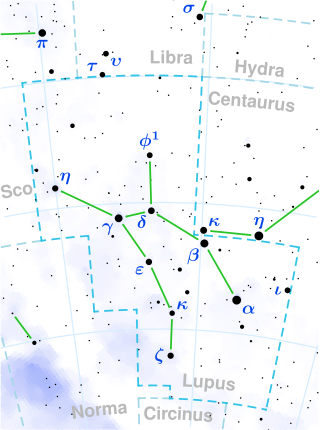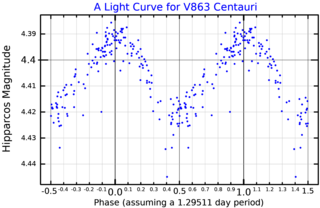Related Research Articles
Omicron Scorpii is a star in the zodiac constellation of Scorpius. With an apparent visual magnitude of +4.57, it is visible to the naked eye. Parallax measurements indicate a distance of roughly 900 light years. It is located in the proximity of the Rho Ophiuchi dark cloud.

Eta Centauri, Latinized from η Centauri, is a star in the southern constellation of Centaurus. It has an apparent visual magnitude of +2.35 and is located at a distance of around 306 light-years.

Epsilon Centauri is a star in the southern constellation of Centaurus. It is one of the brightest stars in the constellation with a slightly variable apparent visual magnitude of +2.30. Parallax measurements put it at a distance of around 430 light-years from Earth.

Delta Centauri, Latinized from δ Centauri, is a star in the southern constellation of Centaurus. The apparent visual magnitude of this star is +2.57, making it readily visible to the naked eye. Based upon parallax measurements, it is located at a distance of about 410 light-years from the Earth. The star is drifting further away with a radial velocity of +11 km/s.

Kappa Centauri is a binary star in the southern constellation of Centaurus. With an apparent visual magnitude of +3.14, it can be viewed with the naked eye on a dark night. Parallax measurements place it at an estimated distance of 380 light-years from Earth.

Nu Centauri, Latinized from ν Centauri, is a binary star system in the southern constellation of Centaurus. The combined apparent visual magnitude of the pair is +3.41, making this one of the brightest members of the constellation. Based upon parallax measurements made during the Hipparcos mission, this star system is located at a distance of roughly 437 light-years from Earth. The margin of error for this distance is about 2%, which is enough to give an error in distance of ±10 light years.

Mu Centauri, Latinized from μ Centauri, is a third-magnitude star in the southern constellation of Centaurus. With the stars ν and φ Centauri, it marks what has been traditionally portrayed as "dextro Latere" of the Centaur. The apparent visual magnitude of this star is 3.42, making it one of the brighter members of the constellation. The distance to this star can be estimated directly using parallax measurements, which yield a value of roughly 510 light years (155 parsecs) from Earth.

Phi Centauri, Latinized from φ Centauri, is a blue-white hued star in the southern constellation Centaurus. It is visible to the naked eye with an apparent visual magnitude of +3.7. The annual parallax shift is 6.21 mas as measured from Earth, which yields a distance estimate of around 530 light years. It is moving further from the Sun with a radial velocity of +5 km/s.
Sigma Centauri, Latinized from σ Centauri, is the Bayer designation for a solitary star in the southern constellation of Centaurus. It is visible to the naked eye with an apparent visual magnitude of 3.91. A visual companion at an angular separation of 88.11±0.37 mas along a position angle of 14.33°±2.59° was detected in 2010 using interferometry, but its association with Sigma Centauri remains undetermined as of 2013. The distance to Sigma Centauri, based upon an annual parallax shift of 7.92 mas, is around 412 light years.

Rho Centauri, Latinized from ρ Centauri, is a binary star system in the southern constellation of Centaurus. It is visible to the naked eye as a blue-white hued point of light with a combined apparent visual magnitude of +3.97. The system is located approximately 276 light years from the Sun based on parallax, and is drifting further away with a radial velocity of around +15 km/s. It is a proper motion member of the Lower Centaurus–Crux sub-group in the Scorpius–Centaurus OB association, the nearest such association of co-moving massive stars to the Sun.

HD 129116 is a binary star in the northeastern part of Centaurus, east of Menkent. It is also known by its Bayer designation of b Centauri, while HD 129116 is the star's identifier in the Henry Draper catalogue. This object has a blue-white hue and is faintly visible to the naked eye with an apparent visual magnitude of +4.01. It is located at a distance of approximately 325 light years from the Sun based on parallax, and has an absolute magnitude of −1.07.

Xi2 Centauri, Latinized from ξ2 Centauri, is a triple star system in the southern constellation of Centaurus. It is visible to the naked eye with an apparent visual magnitude of 4.30, and forms a wide optical double with the slightly dimmer ξ1 Centauri. Based upon an annual parallax shift of 6.98 mas, Xi2 Centauri lies roughly 470 light years from the Sun. At that distance, the visual magnitude is diminished by an interstellar extinction factor of 0.32 due to intervening dust.
Chi Centauri is a star in the constellation Centaurus.
HD 113703, also known by the Bayer designation f Centauri, is a multiple star system in the southern constellation of Centaurus. The combined apparent visual magnitude of this system is +4.71, which is sufficient to make it faintly visible to the naked eye. The distance to this system is approximately 400 light years based on parallax measurements. It is a member of the Lower Centaurus Crux subgroup of the Scorpius–Centaurus association.

λ Crucis, Latinized as Lambda Crucis, is a single, variable star in the southern constellation Crux, near the constellation border with Centaurus. It is visible to the naked eye as a faint, blue-white hued point of light with an apparent visual magnitude that fluctuates around 4.62. The star is located approximately 384 light-years distant from the Sun based on parallax, and is drifting further away with a radial velocity of +12 km/s. It is a proper motion member of the Lower Centaurus–Crux sub-group in the Scorpius–Centaurus OB association, the nearest such association of co-moving massive stars to the Sun.

Delta Lupi is a star in the southern circumpolar constellation of Lupus. In traditional Chinese astronomy, it is "the 2nd (star) of the Cavalry Officer" (騎官二). With an apparent visual magnitude of 3.2, it is the fourth-brightest star in the constellation. The distance to this star has been measured using the parallax technique, yielding an estimate of roughly 900 light-years with a 15% margin of error.

Alpha Muscae, Latinized from α Muscae, is a star in the southern circumpolar constellation of Musca. With an apparent visual magnitude of +2.7, it is the brightest star in the constellation. The distance to this star has been determined using parallax measurements, giving an estimate of about 315 light-years from Earth.

HD 105382 is a star in the constellation Centaurus. Its apparent magnitude is 4.47. From parallax measurements, it is located 130 parsecs from the sun.
ι Lupi, Latinised as Iota Lupi, is a solitary star in the southern constellation of Lupus. It is visible to the naked eye with an apparent visual magnitude of 3.54. Based upon an annual parallax shift of 9.65 mas as seen from Earth, it is located around 338 light years from the Sun. At that distance, the visual magnitude of the star is diminished by an extinction factor of 0.23 due to interstellar dust. Relative to its neighbors, this star has a peculiar velocity of 27.4±4.9 km/s. It appears to be a member of the Scorpio-Centaurus OB association.
HD 142250 is a star in the constellation Scorpius. It has a visual apparent magnitude of 6.1, being visible to the naked eye only in excellent seeing conditions. From parallax measurements, it is located 486 light-years (149 parsecs) away from Earth. This distance, together with the star's proper motion, indicate that HIP 77900 is a member of the Upper Scorpius subgroup of the Scorpius–Centaurus association, the nearest OB association to the Sun. This subgroup is the youngest of the three of the association, with an estimated age of 11 million years.
References
- 1 2 3 4 5 Perryman, M. A. C.; Lindegren; Kovalevsky; Hoeg; Bastian; Bernacca; Crézé; Donati; Grenon; et al. (April 1997). "The HIPPARCOS Catalogue". Astronomy & Astrophysics . 323: L49–L52. Bibcode:1997A&A...323L..49P.
- 1 2 "CCDM J13226-6059AB -- Double or multiple star". SIMBAD. Centre de Données astronomiques de Strasbourg . Retrieved 2009-09-08.
- ↑ Hiltner, W. A.; Garrison, R. F.; Schild, R. E. (July 1969). "MK Spectral Types for Bright Southern OB Stars". The Astrophysical Journal . 157: 313. Bibcode:1969ApJ...157..313H. doi:10.1086/150069.
- 1 2 Landolt, Arlo U. (August 1969). "UBV Observations of Selected Double Systems, II". Publications of the Astronomical Society of the Pacific. 81 (481): 443–446. Bibcode:1969PASP...81..443L. doi: 10.1086/128801 .
- ↑ Jilinski, E.; Daflon, S.; Cunha, K.; de La Reza, R. (March 2006). "Radial velocity measurements of B stars in the Scorpius–Centaurus association". Astronomy and Astrophysics. 448 (3): 1001–1006. arXiv: astro-ph/0601643 . Bibcode:2006A&A...448.1001J. doi:10.1051/0004-6361:20041614. S2CID 17818058.
- 1 2 de Geus, E. J.; de Zeeuw, P. T.; Lub, J. (June 1989). "Physical parameters of stars in the Scorpio-Centaurus OB association". Astronomy and Astrophysics. 216 (1–2): 44–61. Bibcode:1989A&A...216...44D.
- ↑ Sokolov, N. A. (May 1995). "The determination of T_eff_ of B, A and F main sequence stars from the continuum between 3200 A and 3600 A". Astronomy and Astrophysics Supplement. 110: 553–564. Bibcode:1995A&AS..110..553S.
- 1 2 Wolff, S. C.; et al. (2007). "Rotational Velocities for B0-B3 Stars in Seven Young Clusters: Further Study of the Relationship between Rotation Speed and Density in Star-Forming Regions". The Astronomical Journal . 133 (3): 1092–1103. arXiv: astro-ph/0702133 . Bibcode:2007AJ....133.1092W. doi:10.1086/511002. S2CID 119074863.
- ↑ Shatsky, N.; Tokovinin, A. (2002). "The mass ratio distribution of B-type visual binaries in the Sco OB2 association". Astronomy and Astrophysics. 382: 92–103. arXiv: astro-ph/0109456 . Bibcode:2002A&A...382...92S. doi:10.1051/0004-6361:20011542. S2CID 16697655.
- ↑ Lub, J.; de Geus, E. J.; van de Grift, E. (October 1990). "Walraven photometry of nearby southern OB associations". Astronomy and Astrophysics Supplement Series. 85 (2): 915–970. Bibcode:1990A&AS...85..915D.